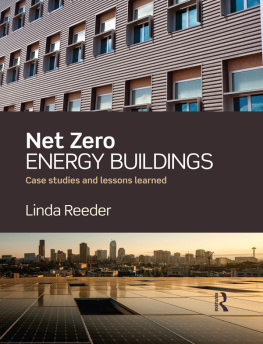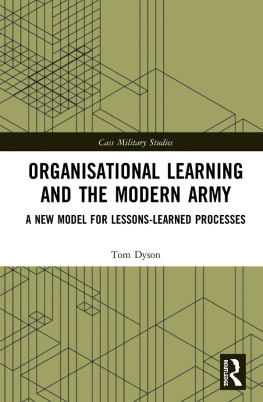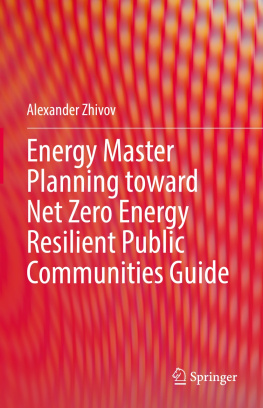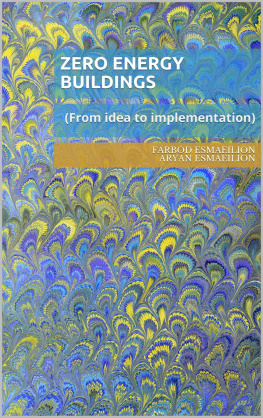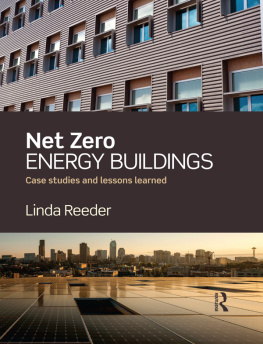Reeder - Net zero energy buildings: case studies and lessons learned
Here you can read online Reeder - Net zero energy buildings: case studies and lessons learned full text of the book (entire story) in english for free. Download pdf and epub, get meaning, cover and reviews about this ebook. City: London [Angleterre, year: 2016, publisher: Routledge, genre: Home and family. Description of the work, (preface) as well as reviews are available. Best literature library LitArk.com created for fans of good reading and offers a wide selection of genres:
Romance novel
Science fiction
Adventure
Detective
Science
History
Home and family
Prose
Art
Politics
Computer
Non-fiction
Religion
Business
Children
Humor
Choose a favorite category and find really read worthwhile books. Enjoy immersion in the world of imagination, feel the emotions of the characters or learn something new for yourself, make an fascinating discovery.
- Book:Net zero energy buildings: case studies and lessons learned
- Author:
- Publisher:Routledge
- Genre:
- Year:2016
- City:London [Angleterre
- Rating:4 / 5
- Favourites:Add to favourites
- Your mark:
- 80
- 1
- 2
- 3
- 4
- 5
Net zero energy buildings: case studies and lessons learned: summary, description and annotation
We offer to read an annotation, description, summary or preface (depends on what the author of the book "Net zero energy buildings: case studies and lessons learned" wrote himself). If you haven't found the necessary information about the book — write in the comments, we will try to find it.
Net zero energy buildings: case studies and lessons learned — read online for free the complete book (whole text) full work
Below is the text of the book, divided by pages. System saving the place of the last page read, allows you to conveniently read the book "Net zero energy buildings: case studies and lessons learned" online for free, without having to search again every time where you left off. Put a bookmark, and you can go to the page where you finished reading at any time.
Font size:
Interval:
Bookmark:
First published 2016
by Routledge
2 Park Square, Milton Park, Abingdon, Oxon OX14 4RN
and by Routledge
711 Third Avenue, New York, NY 10017
Routledge is an imprint of the Taylor & Francis Group, an informa business
2016 Linda Reeder
The right of Linda Reeder to be identified as author of this work has been asserted by her in accordance with sections 77 and 78 of the Copyright, Designs and Patents Act 1988.
All rights reserved. No part of this book may be reprinted or reproduced or utilised in any form or by any electronic, mechanical, or other means, now known or hereafter invented, including photocopying and recording, or in any information storage or retrieval system, without permission in writing from the publishers.
Trademark notice: Product or corporate names may be trademarks or registered trademarks, and are used only for identification and explanation without intent to infringe.
British Library Cataloguing in Publication Data
A catalogue record for this book is available from the British Library
Library of Congress Cataloging-in-Publication Data
Reeder, Linda (Architect), author.
Net zero energy buildings : case studies and lessons learned / Linda Reeder.
pages cm
Includes bibliographical references and index.
ISBN 978-1-138-78123-8 (hardback : alk. paper) -- ISBN 978-1-315-64476-9
(ebook : alk. paper) 1. Sustainable buildings. I. Title.
TH880.R434 2016
720.47--dc23
2015036538
ISBN: 978-1-138-78123-8 (hbk)
ISBN: 978-1-315-64476-9 (ebk)
Typeset in Avenir 9/12 pt
by Fakenham Prepress Solutions, Fakenham, Norfolk NR21 8NN

Linda Reeders book comes along at an exciting timebuilding design professionals have committed to achieving net zero energy in their projects but need to know more about how to design for it. Reeder presents detailed case studies of projects that cover a range of building types, sizes and geographic locations, and all have been measured to perform at net zero energy or better. Her practical and readable study is a clear and solid contribution to the literature of change we need to build a clean energy future.
Edward Mazria, Founder and CEO of Architecture 30
Net Zero Energy Buildings provides a broad look at the current state of the net zero energy building movement. Linda Reeder highlights all the seminal early-21st-century net zero projects, from new large office buildings, historic retrofits, to K-12 schools across a range of climate zones in the US. Not only does Reeder provide 18 case studies to show cost effective and mainstream net zero projects in operations, but she also provides unique insights into common best practices critical for any owner or designer looking to go net zero in their next project.
Shanti Pless, Senior Research Engineer, NREL
Net Zero Energy Buildings provides exactly the kind of information designers, builders, and building owners need today: detailed, technical information on how net-zero-energy performance is being achieved in state-of-the-art buildings. The 18 inspiring projects that Linda Reeder profiles here are reshaping our understanding of what is possible in creating green, sustainable buildings that will help us achieve a carbon-neutral future. This superb book adds immeasurably to the literature on net zero energy buildings.
Alex Wilson, President, Resilient Design Institute
Lessons learned
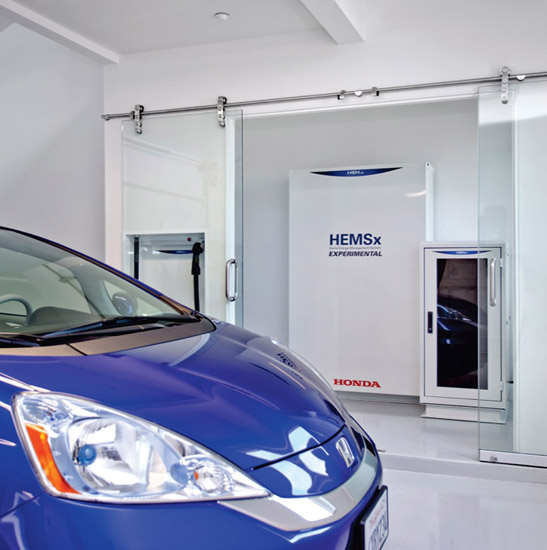
Eco-Village
River Falls, Wisconsin
The St. Croix Valley (SCV) Habitat for Humanity developed this 18-home community out of a sense of responsibility to both the environment and their homebuyers. We began the Eco-Village project recognizing that sustainability is essential to achieving truly affordable homes, said Executive Director David Engstrom. Before beginning this community, the small affiliate had typically constructed only one or two homes each year. (See for a project overview.)
: Project overview
| IECC climate zone | 6A |
| Latitude | 44.86N |
| Context | City of 15,000 located 28 miles southeast of St. Paul, Minnesota |
| Size | 1,074 ft21,949 ft2 (100 m2181 m2) 24 bedrooms |
| Height | 1 or 2 stories |
| Program | Single-family residential (semi-detached) |
| HERS Score with PV | 4 to 17 |
| HERS Score without PV | 33 to 39 |
| ACH at 50 pascal | 0.9 to 1.0 |
| Site | 5.5-acre (22,258 m2) site, with 18 homes planned on 2.5 acres (10,117 m2) |
| Certifications | ENERGY STAR 3.0, LEED for Homes Platinum (anticipated) |
The Eco-Village is pursuing LEED for Homes Platinum certification as well as net zero energy performance. These high-profile goals got the attention of manufacturers and local suppliers. Among the products and materials donated to the project were Fujitsu mini-split systems and Uponor radiant floor, fire sprinkler, and plumbing PEX piping systems. Without these and other in-kind and financial donations, the performance and sustainability goals would not have been attainable. Taking into account the value of donations, the cost per square foot in the first ten homes was as much as two times that of a conventional SCV Habitat for Humanity home.
Habitats approach to sustainability is focused on keeping maintenance and operating costs low. Metal roofs and LP SmartSide trim and lap siding (pre-painted, with 12-year warranty against repainting) help meet this goal. The metal standing seam roofs also allow for mounting PV panels to the roof with S-clips instead of using a rack or penetrating the roofing material.
There are other sustainable features besides durable materials and energy efficiency. The site features rain gardens and driveways made from pervious pavers manufactured with fly ash. Storm water runoff from the road is expected to run under the sidewalk and percolate into the ground. Rainwater is collected in a cistern and used for the community garden, car washing, and irrigating lawns. Low-VOC materials are used inside the home, and ventilation exceeds requirements.
Eighteen single-family homes are planned for 2.5 acres of the 5.5-acre site, which also hosts a walking trail, community garden, and planned community center (see for project team members).
Habitat for Humanity began construction in 2012, completing the first six homescomprised of three twin or attached homes (see )for occupancy during the summer of 2013. Four more homes were completed in 2014. The SCV Habitat for Humanity expects to finish the remaining eight homes in late 2015, followed by construction of the community center. A 60 kW to 80 kW community solar garden of ground-mounted solar panels is planned for the south end of the site, which will further increase the communitys renewable energy generation.
: Project team
| Developer and General Contractor | St. Croix Valley Habitat for Humanity |
| Architect for original design | Frisbie Architects |
| Architect for later homes | Quintus 3D Architecture |
| Energy Design and Analysis | St. Croix Energy Solutions and Building Knowledge |
| M/E/P Contractor | Steiner Plumbing, Electric & Heating |
Font size:
Interval:
Bookmark:
Similar books «Net zero energy buildings: case studies and lessons learned»
Look at similar books to Net zero energy buildings: case studies and lessons learned. We have selected literature similar in name and meaning in the hope of providing readers with more options to find new, interesting, not yet read works.
Discussion, reviews of the book Net zero energy buildings: case studies and lessons learned and just readers' own opinions. Leave your comments, write what you think about the work, its meaning or the main characters. Specify what exactly you liked and what you didn't like, and why you think so.

